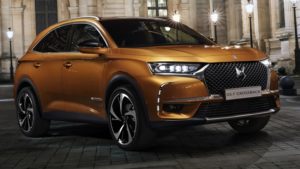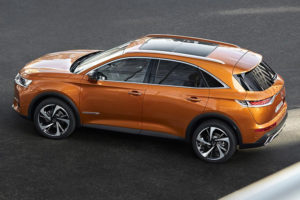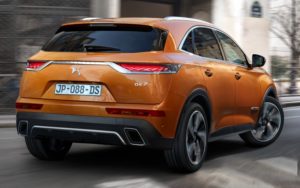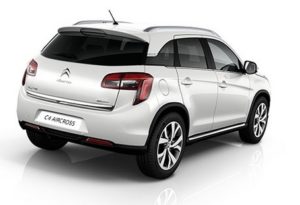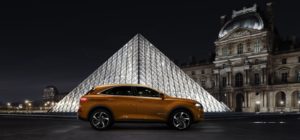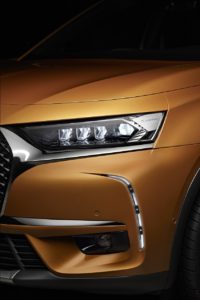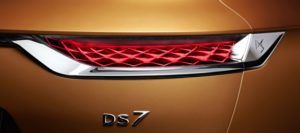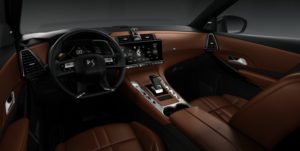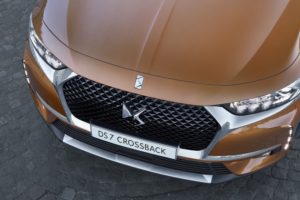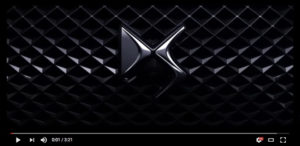Wanting an ever strengthening foothold in the burgeoning SUV market, Citroën has taken aim at the likes of the Audi Q5, BMW X1, Lexus NX, Jaguar F, and Mercedes GL offerings with their DS 7 Crossback. With luxurious room for five, features that include night vision with obstacle detection, driver attention monitoring and DS Active Scan Suspension that uses a camera, four attitude sensors and three accelerometers to scan the road ahead for bumps and dips, adjusting the damper settings accordingly, (similar to Mercedes’ Magic Body Control), the DS 7 gives the company a formidable contender.
The DS 7 does not set a market trend. Rather it fits into the segment with styling pretty much indistinguishable from the rest. That’s not to say it’s bland, but certainly it is not a revolutionary design. More of a evolution of the Wild Rubis concept that Citroën showed back in 2013 that at the time they said would be destined for the Chinese market. That eventually became the C4 Aircross.
This time the emphasis was about ticking all the boxes to get the overall packaging correct. With strong competition, that strategy makes sense and Citroën have done an admirable job.
At 4.57 metres long, 1.89 metres wide and 1.62 metres high the DS 7 tries to emphasize a muscle look with a larger DS winged grille. Along the sides, there are strong shoulder lines over the front and rear wheel arches.
Active LED headlights up front pivot like the classic DS and SM – up to 180 degrees and entertaining observers doing so when the car is unlocked. The rear features a wraparound tailgate and slim LED tail lights (like the Jaguar F SUV) laser-etched to look like three-dimensional scales. Wheel sizes range from 17 to 20 inches.
The stylish interior takes inspiration from luxury watchmaking and haute couture, with a “Clous de Paris” guilloche engraving adorning the centre console toggle switches, while “pearl” stitching can be found on the dashboard and door panels. The Nappa seat upholstery has also been designed to look like a watch strap.
Up to four customization themes, called “Inspirations,” are offered – Bastille, Tivoli, Opera and Performance Line. These use materials such as leather, wood and Alcantara in different ways, across the dashboard, door panels and seats. The center display switch can even specified in glass crystal.
Instrumentation is via two LED screens; the center 12-inch screen contains navigation, MirrorScreen and DS Connect functions, another 12-inch display is used as a virtual instrument cluster ahead of the driver. Between the center air vents sits a BRM R180 clock that is hidden out of sight when the car is turned off. A 14-speaker Focal Electra Hi-Fi sound system is also offered.
Technically speaking, the DS7 debuts the company’s DS Connected Pilot semi-autonomous driving function, inclusive of Stop and Go Active Cruise Control that adjusts the speed and steers in the centre of the lane at speed of up to 180 km/h. There’s also a fully-automated DS Park Pilot that handles steering, acceleration, braking and gear changes.
The DS 7 Crossback has not been named as the first vehicle that PSA will offer in North America, but it’s features, save for the lack of all-wheel-drive at the outset, would certainly appeal to American customers.
Engine efficiency is now in vogue and the DS 7 delivers a few options that should satisfy most looking to haul light to moderate loads; There are a range of five engines, including a 1.6 litre THP turbocharged four-cylinder engine in 180 hp and 225 hp forms, a 130 hp 1.2 litre PureTech turbo three-pot and a 1.6 litre BlueHDi turbodiesel with either 130 hp or 180 hp. Transmission options include a six-speed manual transmission and a new eight-speed automatic transmission that promises to be 2 kg lighter and 4% more fuel efficient.
A plug-in hybrid version called E-Tense was also announced that utilizes a 200 hp version of the 1.6 litre petrol engine, mated to the eight-speed automatic and two 109 hp electric motors – one at the front, the other at the rear, providing all-wheel drive – to produce a total system output of 300 hp. A 13 kWh lithium-ion battery under the rear seat floor provides juice, enabling an all-electric range of 60 km. Again, a practical approach that should appease those looking to seen as green keeners while still owning a SUV.
Here’s Citroën’s introductory video of the DS 7:

